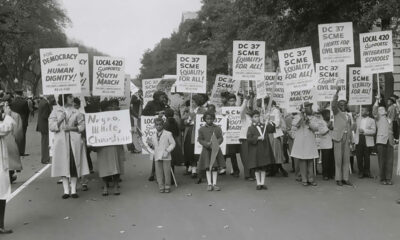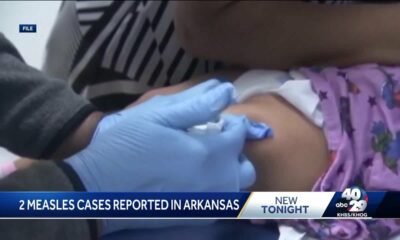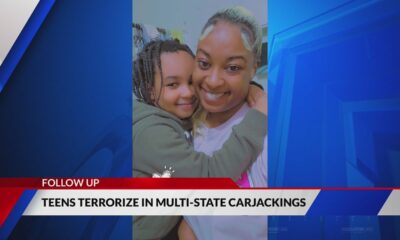Kaiser Health News
Pregnancy Care Was Always Lacking in Jails. It Could Get Worse.

Renuka Rayasam
Fri, 23 Feb 2024 10:00:00 +0000
It was about midnight in June 2022 when police officers showed up at Angela Collier’s door and told her that someone anonymously requested a welfare check because they thought she might have had a miscarriage.
Standing in front of the concrete steps of her home in Midway, Texas, Collier, initially barefoot and wearing a baggy gray T-shirt, told officers she planned to see a doctor in the morning because she had been bleeding.
Police body camera footage obtained by KFF Health News through an open records request shows that the officers then told Collier — who was 29 at the time and enrolled in online classes to study psychology — to turn around.
Instead of taking her to get medical care, they handcuffed and arrested her because she had outstanding warrants in a neighboring county for failing to appear in court to face misdemeanor drug charges three weeks earlier. She had missed that court date, medical records show, because she was at a hospital receiving treatment for pregnancy complications.
Despite her symptoms and being about 13 weeks pregnant, Collier spent the next day and a half in the Walker County Jail, about 80 miles north of Houston. She said her bleeding worsened there and she begged repeatedly for medical attention that she didn’t receive, according to a formal complaint she filed with the Texas Commission on Jail Standards.
“There wasn’t anything I could do,” she said, but “just lay there and be scared and not know what was going to happen.”
Collier’s experience highlights the limited oversight and absence of federal standards for reproductive care for pregnant women in the criminal justice system. Incarcerated people have a constitutional right to health care, yet only a half-dozen states have passed laws guaranteeing access to prenatal or postpartum medical care for people in custody, according to a review of reproductive health care legislation for incarcerated people by a research group at Johns Hopkins School of Medicine. And now abortion restrictions might be putting care further out of reach.
Collier’s arrest was “shocking and disturbing” because officers “blithely” took her to jail despite her miscarriage concerns, said Wanda Bertram, a spokesperson for the Prison Policy Initiative, a nonprofit organization that studies incarceration. Bertram reviewed the body cam footage and Collier’s complaint.
“Police arrest people who are in medical emergencies all the time,” she said. “And they do that regardless of the fact that the jail is often not equipped to care for those people in the way an emergency room might be.”
After a decline during the first year of the pandemic, the number of women in U.S. jails is once again rising, hitting nearly 93,000 in June 2022, a 33% increase over 2020, according to the Department of Justice. Tens of thousands of pregnant women enter U.S. jails each year, according to estimates by Carolyn Sufrin, an associate professor of gynecology and obstetrics at Johns Hopkins School of Medicine, who researches pregnancy care in jails and prisons.
The health care needs of incarcerated women have “always been an afterthought,” said Dana Sussman, deputy executive director at Pregnancy Justice, an organization that defends women who have been charged with crimes related to their pregnancy, such as substance use. For example, about half of states don’t provide free menstrual products in jails and prisons. “And then the needs of pregnant women are an afterthought beyond that,” Sussman said.
Researchers and advocates worry that confusion over recent abortion restrictions may further complicate the situation. A nurse cited Texas’ abortion laws as one reason Collier didn’t need care, according to her statement to the standards commission.
Texas law allows treatment of miscarriage and ectopic pregnancies, a life-threatening condition in which a fertilized egg implants outside the uterus. However, different interpretations of the law can create confusion.
A nurse told Collier that “hospitals no longer did dilation and curettage,” Collier told the commission. “Since I wasn’t hemorrhaging to the point of completely soaking my pants, there wasn’t anything that could be done for me,” she said.
Collier testified that she saw a nurse only once during her stay in jail, even after she repeatedly asked jail staffers for help. The nurse checked her temperature and blood pressure and told her to put in a formal request for Tylenol. Collier said she completed her miscarriage shortly after being released.
Collier’s case is a “canary in a coal mine” for what is happening in jails; abortion restrictions are “going to have a huge ripple effect on a system already unequipped to handle obstetric emergencies,” Sufrin said.
‘There Are No Consequences’
Jail and prison health policies vary widely around the country and often fall far short of the American College of Obstetricians and Gynecologists’ guidelines for reproductive health care for incarcerated people. ACOG and other groups recommend that incarcerated women have access to unscheduled or emergency obstetric visits on a 24-hour basis and that on-site health care providers should be better trained to recognize pregnancy problems.
In Alabama, where women have been jailed for substance use during pregnancy, the state offers pregnancy tests in jail. But it doesn’t guarantee a minimum standard of prenatal care, such as access to extra food and medical visits, according to Johns Hopkins’ review.
Policies for pregnant women at federal facilities also don’t align with national standards for nutrition, safe housing, and access to medical care, according to a 2021 report from the Government Accountability Office.
Even when laws exist to ensure that incarcerated pregnant women have access to care, the language is often vague, leaving discretion to jail personnel.
Since 2020, Tennessee law has required that jails and prisons provide pregnant women “regular prenatal and postpartum care, as necessary.” But last August a woman gave birth in a jail cell after seeking medical attention for more than an hour, according to the Montgomery County Sheriff’s Office.
Pregnancy complications can quickly escalate into life-threatening situations, requiring more timely and specialized care than jails can often provide, said Sufrin. And when jails fail to comply with laws on the books, little oversight or enforcement may exist.
In Louisiana, many jails didn’t consistently follow laws that aimed to improve access to reproductive health care, such as providing free menstrual items, according to a May 2023 report commissioned by state lawmakers. The report also said jails weren’t transparent about whether they followed other laws, such as prohibiting the use of solitary confinement for pregnant women.
Krishnaveni Gundu, as co-founder of the Texas Jail Project, which advocates for people held in county jails, has lobbied for more than a decade to strengthen state protections for pregnant incarcerated people.
In 2019, Texas became one of the few states to require that jails’ health policies include obstetrical and gynecological care. The law requires jails to promptly transport a pregnant person in labor to a hospital, and additional regulations mandate access to medical and mental health care for miscarriages and other pregnancy complications.
But Gundu said lack of oversight and meaningful enforcement mechanisms, along with “apathy” among jail employees, have undermined regulatory protections.
“All those reforms feel futile,” said Gundu, who helped Collier prepare for her testimony. “There are no consequences.”
Before her arrest, Collier had been to the hospital twice that month experiencing pregnancy complications, including a bladder infection, her medical records show. Yet the commission found that Walker County Jail didn’t violate minimum standards. The commission did not consider the police body cam footage or Collier’s personal medical records, which support her assertions of pregnancy complications, according to investigation documents obtained by KFF Health News via an open records request.
In making its determination, the commission relied mainly on the jail’s medical records, which note that Collier asked for medical attention for a miscarriage once, in the morning on the day she was released, and refused Tylenol.
“Your complaint of no medical care is unfounded,” the commission concluded, “and no further action will be taken.”
Collier’s miscarriage had ended before she entered the jail, argued Lt. Keith DeHart, jail lieutenant for the Walker County Sheriff’s Office. “I believe there was some misunderstanding,” he said.
Brandon Wood, executive director of the commission, wouldn’t comment on Collier’s case but defends the group’s investigation as thorough. Jails “have a duty to ensure that those records are accurate and truthful,” he said. And most Texas jails are complying with heightened standards, he said.
Bertram disagrees, saying the fact that care was denied to someone who was begging for it speaks volumes. “That should tell you something about what these standards are worth,” she said.
Last year, Chiree Harley spent six weeks in a Comal County, Texas, jail shortly after discovering she was pregnant and before she could get prenatal care, she said.
I was “thinking that I was going to be well taken care of,” said Harley, 37, who also struggled with substance use.
Jail officials put her in the infirmary, Harley said, but she saw only a jail doctor and never visited an OB-GYN, even though she had previous pregnancy complications including losing multiple pregnancies at around 21 weeks. This time she had no idea how far along she was.
She said that she started leaking amniotic fluid and having contractions on Nov. 1, but that jail officials waited nearly two days to take her to a hospital. Harley said officers forced her to sign papers releasing her from jail custody while she was having contractions in the hospital. Harley delivered at 23 weeks; the baby boy died less than a day later in her arms.
The whole experience was “very scary,” Harley said. “Afterwards we were all very, very devastated.”
Comal County declined to send Harley’s medical and other records in response to an open records request. Michael Shaunessy, a partner at McGinnis Lochridge who represents Comal County, said in a statement that, “at all times, the Comal County Jail provided Chiree Harley with all appropriate and necessary medical treatment for her and her unborn child.” He did not respond to questions about whether Harley was provided specialized obstetric care.
‘I Trusted Those People’
In states like Idaho, Mississippi, and Louisiana that installed near-total abortion bans after the Supreme Court eliminated the constitutional right to abortion in 2022, some patients might have to wait until no fetal cardiac activity is detected before they can get care, said Kari White, the executive and scientific director of Resound Research for Reproductive Health.
White co-authored a recent study that documented 50 cases in which pregnancy care deviated from the standard because of abortion restrictions even outside of jails and prisons. Health care providers who worry about running afoul of strict laws might tell patients to go home and wait until their situations worsen.
“Obviously, it’s much trickier for people who are in jail or in prison, because they are not going to necessarily be able to leave again,” she said.
Advocates argue that boosting oversight and standards is a start, but that states need to find other ways to manage pregnant women who get caught in the justice system.
For many pregnant people, even a short stay in jail can cause lasting trauma and interrupt crucial prenatal care.
Collier remembers being in “disbelief” when she was first arrested but said she was not “distraught.”
“I figured I would be taken care of, that nothing bad was gonna happen to me,” she said. As it became clear that she wouldn’t get care, she grew distressed.
After her miscarriage, Collier saw a mental health specialist and started medication to treat depression. She hasn’t returned to her studies, she said.
“I trusted those people,” Collier said about the jail staff. “The whole experience really messed my head up.”
——————————
By: Renuka Rayasam
Title: Pregnancy Care Was Always Lacking in Jails. It Could Get Worse.
Sourced From: kffhealthnews.org/news/article/pregnancy-care-jails-prisons-incarcerated-women/
Published Date: Fri, 23 Feb 2024 10:00:00 +0000
Kaiser Health News
US Judge Names Receiver To Take Over California Prisons’ Mental Health Program

SACRAMENTO, Calif. — A judge has initiated a federal court takeover of California’s troubled prison mental health system by naming the former head of the Federal Bureau of Prisons to serve as receiver, giving her four months to craft a plan to provide adequate care for tens of thousands of prisoners with serious mental illness.
Senior U.S. District Judge Kimberly Mueller issued her order March 19, identifying Colette Peters as the nominated receiver. Peters, who was Oregon’s first female corrections director and known as a reformer, ran the scandal-plagued federal prison system for 30 months until President Donald Trump took office in January. During her tenure, she closed a women’s prison in Dublin, east of Oakland, that had become known as the “rape club.”
Michael Bien, who represents prisoners with mental illness in the long-running prison lawsuit, said Peters is a good choice. Bien said Peters’ time in Oregon and Washington, D.C., showed that she “kind of buys into the fact that there are things we can do better in the American system.”
“We took strong objection to many things that happened under her tenure at the BOP, but I do think that this is a different job and she’s capable of doing it,” said Bien, whose firm also represents women who were housed at the shuttered federal women’s prison.
California corrections officials called Peters “highly qualified” in a statement, while Gov. Gavin Newsom’s office did not immediately comment. Mueller gave the parties until March 28 to show cause why Peters should not be appointed.
Peters is not talking to the media at this time, Bien said. The judge said Peters is to be paid $400,000 a year, prorated for the four-month period.
About 34,000 people incarcerated in California prisons have been diagnosed with serious mental illnesses, representing more than a third of California’s prison population, who face harm because of the state’s noncompliance, Mueller said.
Appointing a receiver is a rare step taken when federal judges feel they have exhausted other options. A receiver took control of Alabama’s correctional system in 1976, and they have otherwise been used to govern prisons and jails only about a dozen times, mostly to combat poor conditions caused by overcrowding. Attorneys representing inmates in Arizona have asked a judge to take over prison health care there.
Mueller’s appointment of a receiver comes nearly 20 years after a different federal judge seized control of California’s prison medical system and installed a receiver, currently J. Clark Kelso, with broad powers to hire, fire, and spend the state’s money.
California officials initially said in August that they would not oppose a receivership for the mental health program provided that the receiver was also Kelso, saying then that federal control “has successfully transformed medical care” in California prisons. But Kelso withdrew from consideration in September, as did two subsequent candidates. Kelso said he could not act “zealously and with fidelity as receiver in both cases.”
Both cases have been running for so long that they are now overseen by a second generation of judges. The original federal judges, in a legal battle that reached the U.S. Supreme Court, more than a decade ago forced California to significantly reduce prison crowding in a bid to improve medical and mental health care for incarcerated people.
State officials in court filings defended their improvements over the decades. Prisoners’ attorneys countered that treatment remains poor, as evidenced in part by the system’s record-high suicide rate, topping 31 suicides per 100,000 prisoners, nearly double that in federal prisons.
“More than a quarter of the 30 class-members who died by suicide in 2023 received inadequate care because of understaffing,” prisoners’ attorneys wrote in January, citing the prison system’s own analysis. One prisoner did not receive mental health appointments for seven months “before he hanged himself with a bedsheet.”
They argued that the November passage of a ballot measure increasing criminal penalties for some drug and theft crimes is likely to increase the prison population and worsen staffing shortages.
California officials argued in January that Mueller isn’t legally justified in appointing a receiver because “progress has been slow at times but it has not stalled.”
Mueller has countered that she had no choice but to appoint an outside professional to run the prisons’ mental health program, given officials’ intransigence even after she held top officials in contempt of court and levied fines topping $110 million in June. Those extreme actions, she said, only triggered more delays.
The 9th U.S. Circuit Court of Appeals on March 19 upheld Mueller’s contempt ruling but said she didn’t sufficiently justify calculating the fines by doubling the state’s monthly salary savings from understaffing prisons. It upheld the fines to the extent that they reflect the state’s actual salary savings but sent the case back to Mueller to justify any higher penalty.
Mueller had been set to begin additional civil contempt proceedings against state officials for their failure to meet two other court requirements: adequately staffing the prison system’s psychiatric inpatient program and improving suicide prevention measures. Those could bring additional fines topping tens of millions of dollars.
But she said her initial contempt order has not had the intended effect of compelling compliance. Mueller wrote as far back as July that additional contempt rulings would also be likely to be ineffective as state officials continued to appeal and seek delays, leading “to even more unending litigation, litigation, litigation.”
She went on to foreshadow her latest order naming a receiver in a preliminary order: “There is one step the court has taken great pains to avoid. But at this point,” Mueller wrote, “the court concludes the only way to achieve full compliance in this action is for the court to appoint its own receiver.”
This article was produced by KFF Health News, which publishes California Healthline, an editorially independent service of the California Health Care Foundation.
If you or someone you know may be experiencing a mental health crisis, contact the 988 Suicide & Crisis Lifeline by dialing or texting “988.”
The post US Judge Names Receiver To Take Over California Prisons’ Mental Health Program appeared first on kffhealthnews.org
Kaiser Health News
Amid Plummeting Diversity at Medical Schools, a Warning of DEI Crackdown’s ‘Chilling Effect’

The Trump administration’s crackdown on DEI programs could exacerbate an unexpectedly steep drop in diversity among medical school students, even in states like California, where public universities have been navigating bans on affirmative action for decades. Education and health experts warn that, ultimately, this could harm patient care.
Since taking office, President Donald Trump has issued a handful of executive orders aimed at terminating all diversity, equity, and inclusion, or DEI, initiatives in federally funded programs. And in his March 4 address to Congress, he described the Supreme Court’s 2023 decision banning the consideration of race in college and university admissions as “brave and very powerful.”
Last month, the Education Department’s Office for Civil Rights — which lost about 50% of its staff in mid-March — directed schools, including postsecondary institutions, to end race-based programs or risk losing federal funding. The “Dear Colleague” letter cited the Supreme Court’s decision.
Paulette Granberry Russell, president and CEO of the National Association of Diversity Officers in Higher Education, said that “every utterance of ‘diversity’ is now being viewed as a violation or considered unlawful or illegal.” Her organization filed a lawsuit challenging Trump’s anti-DEI executive orders.
While California and eight other states — Arizona, Florida, Idaho, Michigan, Nebraska, New Hampshire, Oklahoma, and Washington — had already implemented bans of varying degrees on race-based admissions policies well before the Supreme Court decision, schools bolstered diversity in their ranks with equity initiatives such as targeted scholarships, trainings, and recruitment programs.
But the court’s decision and the subsequent state-level backlash — 29 states have since introduced bills to curb diversity initiatives, according to data published by the Chronicle of Higher Education — have tamped down these efforts and led to the recent declines in diversity numbers, education experts said.
After the Supreme Court’s ruling, the numbers of Black and Hispanic medical school enrollees fell by double-digit percentages in the 2024-25 school year compared with the previous year, according to the Association of American Medical Colleges. Black enrollees declined 11.6%, while the number of new students of Hispanic origin fell 10.8%. The decline in enrollment of American Indian or Alaska Native students was even more dramatic, at 22.1%. New Native Hawaiian or other Pacific Islander enrollment declined 4.3%.
“We knew this would happen,” said Norma Poll-Hunter, AAMC’s senior director of workforce diversity. “But it was double digits — much larger than what we anticipated.”
The fear among educators is the numbers will decline even more under the new administration.
At the end of February, the Education Department launched an online portal encouraging people to “report illegal discriminatory practices at institutions of learning,” stating that students should have “learning free of divisive ideologies and indoctrination.” The agency later issued a “Frequently Asked Questions” document about its new policies, clarifying that it was acceptable to observe events like Black History Month but warning schools that they “must consider whether any school programming discourages members of all races from attending.”
“It definitely has a chilling effect,” Poll-Hunter said. “There is a lot of fear that could cause institutions to limit their efforts.”
Numerous requests for comment from medical schools about the impact of the anti-DEI actions went unreturned. University presidents are staying mum on the issue to protect their institutions, according to reporting from The New York Times.
Utibe Essien, a physician and UCLA assistant professor, said he has heard from some students who fear they won’t be considered for admission under the new policies. Essien, who co-authored a study on the effect of affirmative action bans on medical schools, also said students are worried medical schools will not be as supportive toward students of color as in the past.
“Both of these fears have the risk of limiting the options of schools folks apply to and potentially those who consider medicine as an option at all,” Essien said, adding that the “lawsuits around equity policies and just the climate of anti-diversity have brought institutions to this place where they feel uncomfortable.”
In early February, the Pacific Legal Foundation filed a lawsuit against the University of California-San Francisco’s Benioff Children’s Hospital Oakland over an internship program designed to introduce “underrepresented minority high school students to health professions.”
Attorney Andrew Quinio filed the suit, which argues that its plaintiff, a white teenager, was not accepted to the program after disclosing in an interview that she identified as white.
“From a legal standpoint, the issue that comes about from all this is: How do you choose diversity without running afoul of the Constitution?” Quinio said. “For those who want diversity as a goal, it cannot be a goal that is achieved with discrimination.”
UC Health spokesperson Heather Harper declined to comment on the suit on behalf of the hospital system.
Another lawsuit filed in February accuses the University of California of favoring Black and Latino students over Asian American and white applicants in its undergraduate admissions. Specifically, the complaint states that UC officials pushed campuses to use a “holistic” approach to admissions and “move away from objective criteria towards more subjective assessments of the overall appeal of individual candidates.”
The scrutiny of that approach to admissions could threaten diversity at the UC-Davis School of Medicine, which for years has employed a “race-neutral, holistic admissions model” that reportedly tripled enrollment of Black, Latino, and Native American students.
“How do you define diversity? Does it now include the way we consider how someone’s lived experience may be influenced by how they grew up? The type of school, the income of their family? All of those are diversity,” said Granberry Russell, of the National Association of Diversity Officers in Higher Education. “What might they view as an unlawful proxy for diversity equity and inclusion? That’s what we’re confronted with.”
California Attorney General Rob Bonta, a Democrat, recently joined other state attorneys general to issue guidance urging that schools continue their DEI programs despite the federal messaging, saying that legal precedent allows for the activities. California is also among several states suing the administration over its deep cuts to the Education Department.
If the recent decline in diversity among newly enrolled students holds or gets worse, it could have long-term consequences for patient care, academic experts said, pointing toward the vast racial disparities in health outcomes in the U.S., particularly for Black people.
A higher proportion of Black primary care doctors is associated with longer life expectancy and lower mortality rates among Black people, according to a 2023 study published by the JAMA Network.
Physicians of color are also more likely to build their careers in medically underserved communities, studies have shown, which is increasingly important as the AAMC projects a shortage of up to 40,400 primary care doctors by 2036.
“The physician shortage persists, and it’s dire in rural communities,” Poll-Hunter said. “We know that diversity efforts are really about improving access for everyone. More diversity leads to greater access to care — everyone is benefiting from it.”
This article was produced by KFF Health News, which publishes California Healthline, an editorially independent service of the California Health Care Foundation.
The post Amid Plummeting Diversity at Medical Schools, a Warning of DEI Crackdown’s ‘Chilling Effect’ appeared first on kffhealthnews.org
Kaiser Health News
Tribal Health Leaders Say Medicaid Cuts Would Decimate Health Programs

As Congress mulls potentially massive cuts to federal Medicaid funding, health centers that serve Native American communities, such as the Oneida Community Health Center near Green Bay, Wisconsin, are bracing for catastrophe.
That’s because more than 40% of the about 15,000 patients the center serves are enrolled in Medicaid. Cuts to the program would be detrimental to those patients and the facility, said Debra Danforth, the director of the Oneida Comprehensive Health Division and a citizen of the Oneida Nation.
“It would be a tremendous hit,” she said.
The facility provides a range of services to most of the Oneida Nation’s 17,000 people, including ambulatory care, internal medicine, family practice, and obstetrics. The tribe is one of two in Wisconsin that have an “open-door policy,” Danforth said, which means that the facility is open to members of any federally recognized tribe.
But Danforth and many other tribal health officials say Medicaid cuts would cause service reductions at health facilities that serve Native Americans.
Indian Country has a unique relationship to Medicaid, because the program helps tribes cover chronic funding shortfalls from the Indian Health Service, the federal agency responsible for providing health care to Native Americans.
Medicaid has accounted for about two-thirds of third-party revenue for tribal health providers, creating financial stability and helping facilities pay operational costs. More than a million Native Americans enrolled in Medicaid or the closely related Children’s Health Insurance Program also rely on the insurance to pay for care outside of tribal health facilities without going into significant medical debt. Tribal leaders are calling on Congress to exempt tribes from cuts and are preparing to fight to preserve their access.
“Medicaid is one of the ways in which the federal government meets its trust and treaty obligations to provide health care to us,” said Liz Malerba, director of policy and legislative affairs for the United South and Eastern Tribes Sovereignty Protection Fund, a nonprofit policy advocacy organization for 33 tribes spanning from Texas to Maine. Malerba is a citizen of the Mohegan Tribe.
“So we view any disruption or cut to Medicaid as an abrogation of that responsibility,” she said.
Tribes face an arduous task in providing care to a population that experiences severe health disparities, a high incidence of chronic illness, and, at least in western states, a life expectancy of 64 years — the lowest of any demographic group in the U.S. Yet, in recent years, some tribes have expanded access to care for their communities by adding health services and providers, enabled in part by Medicaid reimbursements.
During the last two fiscal years, five urban Indian organizations in Montana saw funding growth of nearly $3 million, said Lisa James, director of development for the Montana Consortium for Urban Indian Health, during a webinar in February organized by the Georgetown University Center for Children and Families and the National Council of Urban Indian Health.
The increased revenue was “instrumental,” James said, allowing clinics in the state to add services that previously had not been available unless referred out for, including behavioral health services. Clinics were also able to expand operating hours and staffing.
Montana’s five urban Indian clinics, in Missoula, Helena, Butte, Great Falls, and Billings, serve 30,000 people, including some who are not Native American or enrolled in a tribe. The clinics provide a wide range of services, including primary care, dental care, disease prevention, health education, and substance use prevention.
James said Medicaid cuts would require Montana’s urban Indian health organizations to cut services and limit their ability to address health disparities.
American Indian and Alaska Native people under age 65 are more likely to be uninsured than white people under 65, but 30% rely on Medicaid compared with 15% of their white counterparts, according to KFF data for 2017 to 2021. More than 40% of American Indian and Alaska Native children are enrolled in Medicaid or CHIP, which provides health insurance to kids whose families are not eligible for Medicaid. KFF is a health information nonprofit that includes KFF Health News.
A Georgetown Center for Children and Families report from January found the share of residents enrolled in Medicaid was higher in counties with a significant Native American presence. The proportion on Medicaid in small-town or rural counties that are mostly within tribal statistical areas, tribal subdivisions, reservations, and other Native-designated lands was 28.7%, compared with 22.7% in other small-town or rural counties. About 50% of children in those Native areas were enrolled in Medicaid.
The federal government has already exempted tribes from some of Trump’s executive orders. In late February, Department of Health and Human Services acting general counsel Sean Keveney clarified that tribal health programs would not be affected by an executive order that diversity, equity, and inclusion government programs be terminated, but that the Indian Health Service is expected to discontinue diversity and inclusion hiring efforts established under an Obama-era rule.
HHS Secretary Robert F. Kennedy Jr. also rescinded the layoffs of more than 900 IHS employees in February just hours after they’d received termination notices. During Kennedy’s Senate confirmation hearings, he said he would appoint a Native American as an assistant HHS secretary. The National Indian Health Board, a Washington, D.C.-based nonprofit that advocates for tribes, in December endorsed elevating the director of the Indian Health Service to assistant secretary of HHS.
Jessica Schubel, a senior health care official in Joe Biden’s White House, said exemptions won’t be enough.
“Just because Native Americans are exempt doesn’t mean that they won’t feel the impact of cuts that are made throughout the rest of the program,” she said.
State leaders are also calling for federal Medicaid spending to be spared because cuts to the program would shift costs onto their budgets. Without sustained federal funding, which can cover more than 70% of costs, state lawmakers face decisions such as whether to change eligibility requirements to slim Medicaid rolls, which could cause some Native Americans to lose their health coverage.
Tribal leaders noted that state governments do not have the same responsibility to them as the federal government, yet they face large variations in how they interact with Medicaid depending on their state programs.
President Donald Trump has made seemingly conflicting statements about Medicaid cuts, saying in an interview on Fox News in February that Medicaid and Medicare wouldn’t be touched. In a social media post the same week, Trump expressed strong support for a House budget resolution that would likely require Medicaid cuts.
The budget proposal, which the House approved in late February, requires lawmakers to cut spending to offset tax breaks. The House Committee on Energy and Commerce, which oversees spending on Medicaid and Medicare, is instructed to slash $880 billion over the next decade. The possibility of cuts to the program that, together with CHIP, provides insurance to 79 million people has drawn opposition from national and state organizations.
The federal government reimburses IHS and tribal health facilities 100% of billed costs for American Indian and Alaska Native patients, shielding state budgets from the costs.
Because Medicaid is already a stopgap fix for Native American health programs, tribal leaders said it won’t be a matter of replacing the money but operating with less.
“When you’re talking about somewhere between 30% to 60% of a facility’s budget is made up by Medicaid dollars, that’s a very difficult hole to try and backfill,” said Winn Davis, congressional relations director for the National Indian Health Board.
Congress isn’t required to consult tribes during the budget process, Davis added. Only after changes are made by the Centers for Medicare & Medicaid Services and state agencies are tribes able to engage with them on implementation.
The amount the federal government spends funding the Native American health system is a much smaller portion of its budget than Medicaid. The IHS projected billing Medicaid about $1.3 billion this fiscal year, which represents less than half of 1% of overall federal spending on Medicaid.
“We are saving more lives,” Malerba said of the additional services Medicaid covers in tribal health care. “It brings us closer to a level of 21st century care that we should all have access to but don’t always.”
This article was published with the support of the Journalism & Women Symposium (JAWS) Health Journalism Fellowship, assisted by grants from The Commonwealth Fund.
KFF Health News is a national newsroom that produces in-depth journalism about health issues and is one of the core operating programs at KFF—an independent source of health policy research, polling, and journalism. Learn more about KFF.
USE OUR CONTENT
This story can be republished for free (details).
The post Tribal Health Leaders Say Medicaid Cuts Would Decimate Health Programs appeared first on kffhealthnews.org
-

 News from the South - Arkansas News Feed7 days ago
News from the South - Arkansas News Feed7 days agoMeasles cases confirmed in Arkansas children after travel exposure
-

 News from the South - Alabama News Feed7 days ago
News from the South - Alabama News Feed7 days agoImpacts of Overdraft Fees | April 11, 2025 | News 19 at 10 p.m.
-

 News from the South - Georgia News Feed7 days ago
News from the South - Georgia News Feed7 days ago1-on-1 with Gov. Kemp’s Senior Advisor | Full interview
-

 Mississippi Today5 days ago
Mississippi Today5 days agoOn this day in 1873, La. courthouse scene of racial carnage
-

 News from the South - Missouri News Feed7 days ago
News from the South - Missouri News Feed7 days agoMom and son targeted in carjackings, stolen cars crime spree
-

 Local News6 days ago
Local News6 days agoAG Fitch and Children’s Advocacy Centers of Mississippi Announce Statewide Protocol for Child Abuse Response
-

 Local News5 days ago
Local News5 days agoSouthern Miss Professor Inducted into U.S. Hydrographer Hall of Fame
-

 News from the South - Arkansas News Feed7 days ago
News from the South - Arkansas News Feed7 days agoFederal investigators looking into cause of deadly NYC helicopter crash














































